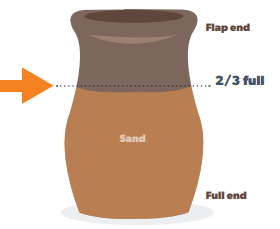There are many things that you can do to ensure you’re flood ready, including sandbagging. Sandbags won’t stop floodwater completely, but can reduce the amount of water entering your home or business.
Sandbag collection points
Where can I collect sandbags
VICSES only set up sandbag collection points when required to assist to prepare at-risk townships. At other times, community may be able to access sandbags from their local hardware store.
Current local sandbag collection points:
Please note locations and operating times may change at short notice.
We recommend 25 sandbags or less per household, depending on your flood risk.
NO SANDBAGGING LOCATIONS CURRENTLY ACTIVATED
It’s important that you know how to correctly fill, lay, and place sandbags. View our sandbagging guide for more information.
Other important emergency information
If you need emergency flood assistance, call VICSES on 132 500.
If life threatening, call Triple Zero (000).
Stay up-to-date with the latest weather forecasts and warnings via the Bureau of Meteorology website, and local incidents and warnings through VicEmergency.
How do I fill a sandbag?

-
Only use sand to fill hessian bags. Do not use dirt.
-
Only fill sandbag two-thirds full. Do not over fill the sandbag as it will be too heavy to carry.
-
Do not tie the top of the sandbag.
-
Take care when filling and lifting the sandbag, to avoid injury.
How do I lay sandbags?
-
Lay sandbags like brickwork. Stagger rows so that the joins do not line up.
-
Start at one end and work to the other end.
-
Ensure the unfilled part of the bag is covered by the next bag.
-
Tuck flap under the bag at the end of the row.
-
If the sandbag wall is going to be more than five (5) bags high, you will need to lay two (2) rows wide.
Where do I place the sandbags?
-
Place sandbags in plastic bags to cover drainage holes in home (e.g. showers, toilets, sinks) to stop back flow of water.
-
Place a small wall across doorways, at least the height of the expected water level. Be careful not to trap yourself inside.
-
If available, plastic sheeting may be used under sandbags to reduce the seepage.
What do I do once I have finished with the sandbags?
If you have used sandbags to protect your home from flooding, it is important that you dispose of them correctly and safely:
-
Sturdy gloves should be worn when handling wet sandbags as they can contain chemicals, waste and diseases.
-
Sandbags that have been in contact with floodwater need to be thrown away.
-
Contact your local council to find out how to dispose of your sandbags safely.







